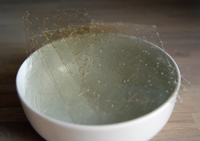
Photo from wikipedia
Short peptide hydrogels are attractive biomaterials but typically suffer from limited mechanical properties. Inclusion of other nanomaterials can serve the dual purpose of hydrogel reinforcement and of conferring additional physicochemical… Click to show full abstract
Short peptide hydrogels are attractive biomaterials but typically suffer from limited mechanical properties. Inclusion of other nanomaterials can serve the dual purpose of hydrogel reinforcement and of conferring additional physicochemical properties ( e. g., self-healing, conductivity), as long as they do not hamper peptide self-assembly. In particular, nanocarbons are ideal candidates, and their physicochemical properties have demonstrated great potential in nanocarbon-polymer gel biomaterials for tissue engineering or drug delivery. Recently, increasing interest in supramolecular hydrogels drove research also on their enhancement with nanocarbons. However, little is known on the effect of nanocarbon morphology on the self-assembly of short peptides, which are among the most popular hydrogel building blocks. In this work, three different oxidized nanocarbons ( i. e., carbon nanotube or CNT as 1D material, graphene oxide sheet or GO as 2D material, and carbon nanohorn or CNH as 3D material) were evaluated for their effects on the self-assembly of the unprotected tripeptide Leu-DPhe-DPhe at physiological conditions. Supramolecular hydrogels were obtained in all cases, and viscoelastic properties were clearly affected by the nanocarbons, which increased stiffness and resistance to applied stress. Notably, self-healing behavior was observed only in the case of CNTs. Tripeptide-nanotube interaction was noted already in solution prior to self-assembly, with the tripeptide acting as a dispersing agent in phosphate buffer. Experimental and in silico investigation of the interaction between peptide and CNTs suggests that the latter acts as nucleation templates for self-assembly and reassembly. Overall, we provide useful insights for the future design of composite biomaterials with acquired properties.
Journal Title: ACS nano
Year Published: 2018
Link to full text (if available)
Share on Social Media: Sign Up to like & get
recommendations!